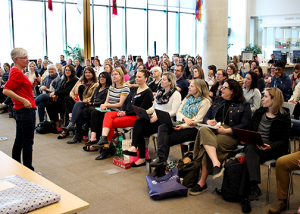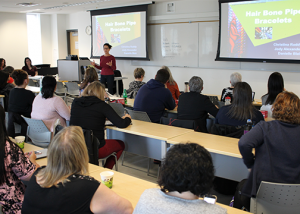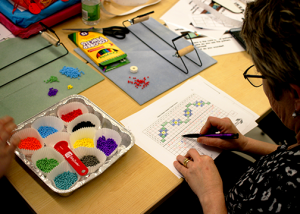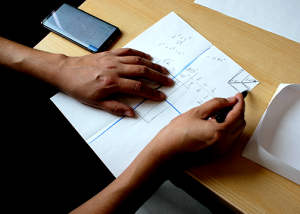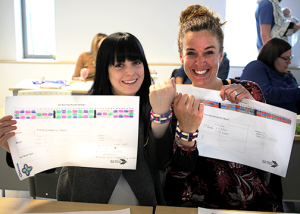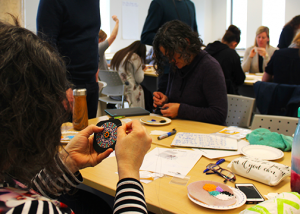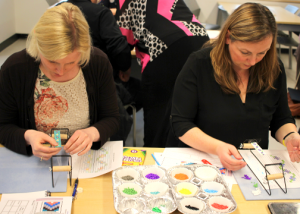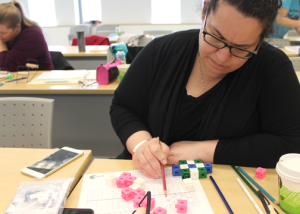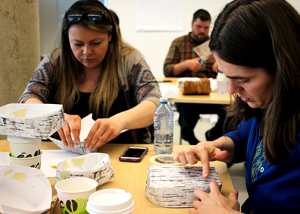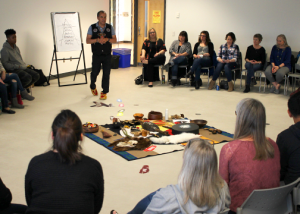This past weekend, Lakehead University hosted the Wiidookaadying Gikinoomaagewin: Gindaaswin Kendaaswin – Relationships and Reciprocity: Indigenous Education and Mathematics Conference at its Orillia campus.
For three days, classroom educators, educational leaders, professors and ministry officials participated in hands-on workshops and facilitated conversations to work towards fostering mutually respectful relationships by integrating Indigenous discourse and practices into the process of knowledge discovery and dissemination. Participants were encouraged to think about how they might deepen or form reciprocal relationships with Indigenous Elders, artists, and educators by focusing on math education.
Organized by Lakehead University’s Ruth Beatty (Associate Professor, Faculty of Education) and a dedicated team of community members and educators from across the province, the conference highlighted several examples of engaging Indigenous knowledge through research carried out with Indigenous community partners.
The projects featured in the conference’s workshops demonstrated how Indigenous knowledge systems can further enhance our conception of reconciliation through education. Workshop leaders shared the experiences and lessons learned in a multi-year study that was founded on working with community, which resulted in culturally responsive approaches to instruction, and learning about conducting classroom-based Indigenous education research.
The conference also featured two keynote addresses. Lisa Lunney Borden, Associate Professor of mathematics education at St. Francis Xavier University, shared what she has learned as a classroom teacher and researcher of equitable education. Lisa inspired the auditorium full of educators by explaining how she is decolonizing mathematics education through culturally-based practices and experiences that are rooted in Aboriginal languages and knowledge systems.
Colinda Clyne, First Nation Métis Inuit Curriculum Lead for the Upper Grand District School Board, and Pam Agawa, Vice-Principal at Keswick High School and former First Nation Métis Inuit Curriculum Coordinator for the York Region Board of Education, spoke about the importance of building strong, trusting relationships between educational professionals and Indigenous communities. They also spoke of the challenges educators may face when working in current educational systems. Together, they are connecting Elders and knowledge keepers with educators and students, and implementing strategies to improve Indigenous student well-being and academic success.
The Robertson Program appreciates the invitation to be a part of this inclusive learning experience. As we continue to find new ways to make math accessible to all children, we value the opportunity to learn from those engaging in work to improve mathematics education and work towards reconciliation with Indigenous communities in Canada. We thank all of the conference organizers, especially Ruth Beatty, our ongoing collaborator and supporter of our work.
Wiidookaadying Gikinoomaagewin: Gindaaswin Kendaaswin Organizing Team
Ruth Beatty, Lakehead University
Christina Ruddy, The Algonquins of Pikwakanagan First Nation
Colinda Clyne, Upper Grand District School Board
Jody Alexander, Ottawa Carleton District School Board
Anika Guthrie, Lakehead District School Board
Robin Debassige, M’Chigeeng First Nation
Thecla Neganegijig, M’Chigeeng First Nation
Pamala Agawa, York Region District School Board
Nathalie Bertin, Métis Artist
Bonnie Sears, Upper Grand District School Board
Danielle Blair, Ways of Knowing Education Consulting
Michael Fitzmaurice, Renfrew County District School Board
Heather Lett, Renfrew County District School Board
Linda Grant, Lakehead University
Paul Minichiello, Lakehead University
Sarah Lorincz, Lakehead University

